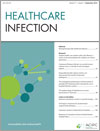
Healthcare Infection
Volume 17 Number 3 2012
HI12014Student health-care workers with cystic fibrosis: a review of recommendations for students on clinical placement
Student health care workers with cystic fibrosis are at potential risk of both transmission and acquisition of multi-resistant organisms while undertaking clinical placement. There are potential adverse outcomes for patients, Health Services and the student’s personal health. This paper reviews currently available Infection Control Guidelines to manage this difficult issue.
HI12011Cutaneous Rhizopus infection at a central venous catheter site in a critically ill renal transplant patient
Invasive fungal infections are increasing in incidence.In the critical care setting, clinicians must retain a high index of suspicion for invasive fungal infections in immunocompromised individuals to ensure early diagnosis and provide aggressive medical and surgical intervention. Liposomal amphoterin B is the first line antimicrobial therapy, and reduction or discontinuation of immunosuppressive therapy should be considered.
HI12015Disposable biocidal cubical curtains: can they prevent the transfer of bacterial pathogens?
Potentially harmful bacteria have been shown to contaminate traditional cloth cubical curtains and they can be transferred from the curtain to patient by the hands of health care workers. This study showed that biocide-treated disposable curtains were effective in eliminating or reducing transmission of the bacteria tested. However, due to spore formation, C. difficile survived on the curtains and new biocidal disposable curtains should contain sporicidal formulations.
HI12021The comparative performance of three brands of portable ATP-bioluminometer intended for use in hospital infection control
Measuring ATP on healthcare surfaces has been suggested as a new and superior way of determining surface cleanliness over traditional surface microbiology. This research examined the reliability of three brands of portable ATP bioluminometers. The results indicate that whilst the three meters were able to distinguish between large differences in ATP, none of the brands were reliable for benchmark usage.
HI12020The epidemiology of Staphylococcus aureus bacteraemia in Tasmania
The epidemiology of Staphylococcus aureus bacteraemia (SAB) at a population level is not well understood. Our study collected data on all cases of SAB occurring in Tasmania, Australia. We found that 11% of SAB cases are identified outside of acute public hospitals, a small percentage of healthcare-associated SAB identified in one facility is attributable to another, and intravascular devices are associated with 55% of healthcare-associated SAB.

